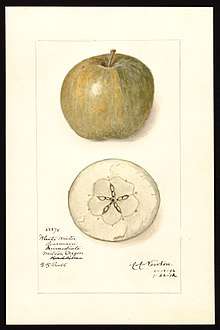Pearmain

A pearmain, also formerly spelt "permain", is a type of apple. The name may once have been applied to a particular variety of apple that kept well, although in more modern times its inclusion in varietal names was, like the term 'Pippin', "largely decoration"[1] rather than indicating any shared qualities. The original 'Pearmain' variety has not been conclusively identified and may now be extinct.
There has been some debate over the origin of the name "pearmain". The pomologist Robert Hogg suggested that it originated in mediaeval times from pyrus magnus, "great pear", and referred to a type of apple having a large pear-like shape.[2] Hogg believed that the variety 'Winter Pearmain' was both "the original of all the Pearmains"[2] and the oldest recorded variety of apple in England, with evidence it was cultivated in Norfolk in c.1200.[2] Other sources suggest that the name was in fact originally used for a type of pear, before being applied to apples during the 16th century;[3] it was derived from Old French pearmain and possibly ultimately from Latin parmensia "of Parma",[3] though the latter is probably folk etymology. A third and more likely derivation, by the philologist Ernest Weekley, suggests the term was again originally applied to pears and came from Middle English parmain, permain, derived from Old French parmaindre "to endure", and referred to the long keeping qualities of some varieties.[4] Rejecting the etymology from parmensia, Weekley noted that 17th century references to a "pompire" or "pyramalum" (i.e. an "apple-pear") suggested that the original 'Pearmain' apple was named for some quality associated with the pearmain pear; i.e. hardness and long keeping ability.[5]
Pearmain apple cultivars include:
- Adams Pearmain
- Baxters Pearmain
- Blue Pearmain[6]
- John Pearmain
- Christmas Pearmain
- Claygate Pearmain
- Foulden Pearmain
- Grange's Pearmain
- Hormead Pearmain
- Hubbard's Pearmain
- King Charles Pearmain
- Lamb Abbey Pearmain
- Laxton's Pearmain
- London Pearmain
- Mannington's Pearmain
- Old Pearmain
- Winter Pearmain
- Worcester Pearmain
There have been many efforts to identify the original 'Pearmain' apple, of supposedly mediaeval origin. Hogg suggested the 'Winter Pearmain' to be the original, and synonymous with the 'Old Pearmain', though S. A. Beach, in his work Apples of New York, noted that "several different varieties" had been propagated in America and England under the name 'Winter Pearmain' and that in many descriptions "it is impossible to determine which Winter Pearmain the writer had in mind".[7] By contrast, Hogg believed the apple identified in some catalogues of the time as 'Old Pearmain' to in fact be a variety called 'Royal Pearmain'.[8] Hogg later claimed to have identified the "true Old Pearmain" growing in the Dymock area.[9] The current 'Old Pearmain' in the National Fruit Collection was received in 1924 from a Mr. Kelsey in Surrey, but is probably neither Hogg's variety nor the ancient 'Pearmain'.[10]
References
- ↑ Smith, A. W. (1963) A Gardener's Handbook of Plant Names: Their Meanings and Origins, p.40
- 1 2 3 Hogg, R. (1851) British Pomology, London: Groombridge, p.209
- 1 2 Ayto (2012) The Diner's Dictionary: Word Origins of Food and Drink, OUP, p.400
- ↑ Weekley (1921) An etymological dictionary of modern English, v2, p.1057
- ↑ Weekley (1926) Words Ancient and Modern, J. Murray, p.82
- ↑ "Blue Pearmain apple". Orange Pippin. Retrieved 19 June 2015.
- ↑ Beach, S. A. (1905) The Apples of New York, v2, p.379
- ↑ Hogg (1851), p.175
- ↑ Hogg (1884) The Fruit Manual, p.169
- ↑ Morgan and Richards (2002) The New Book of Apples, Ebury, p.248
